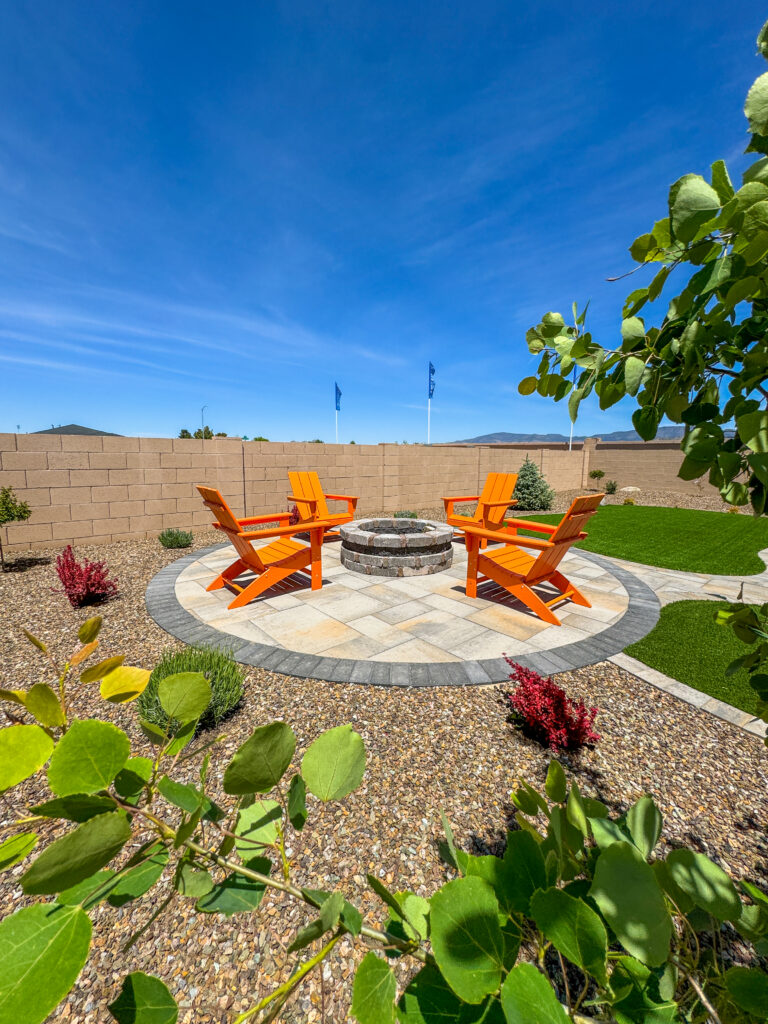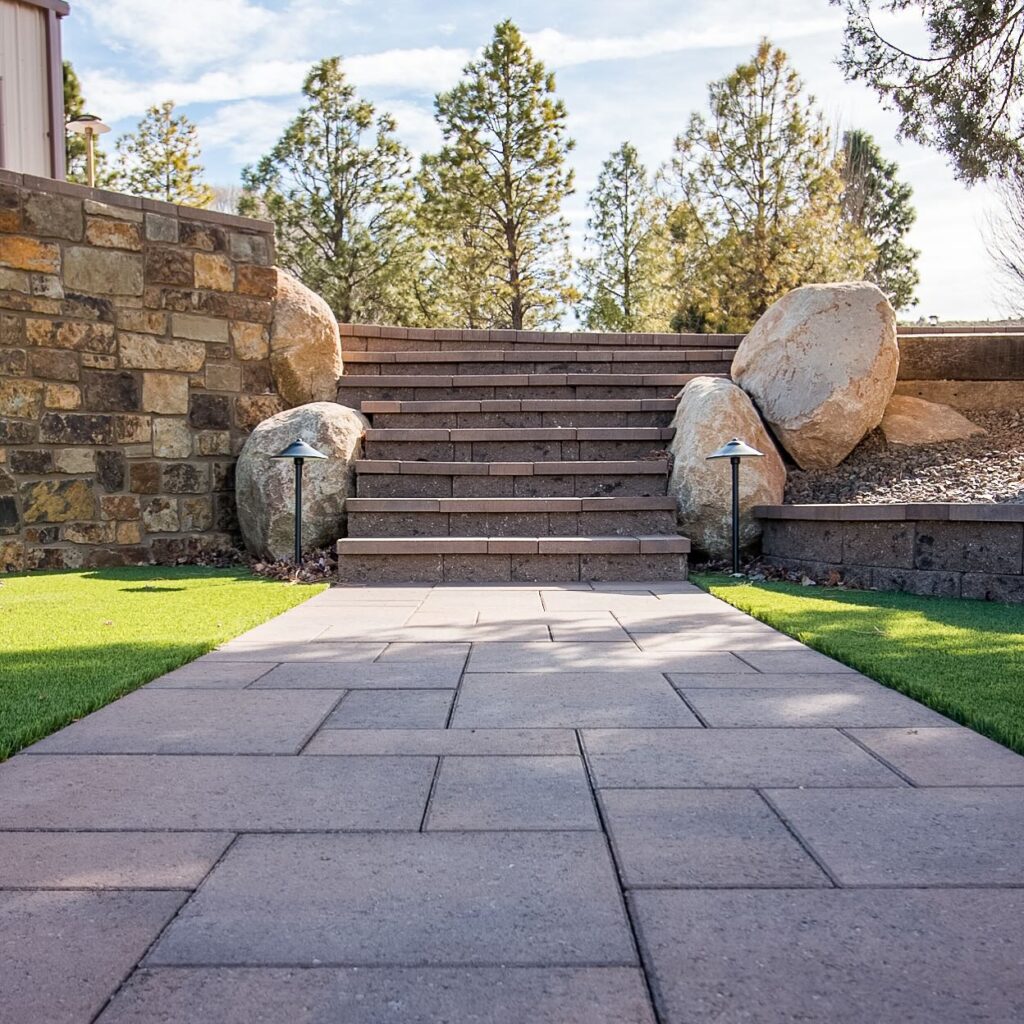
Prescott, Arizona, is known for its beautiful yet challenging landscape. Homeowners face obstacles like steep slopes and rocky areas when designing their outdoor spaces. But, with the right skills and creative ideas, these challenges can be turned into beautiful features.
Understanding Prescott’s terrain and climate is key to overcoming these challenges. Landscape designers must manage drainage and work with the rocky terrain. They need to mix technical skills with creativity to create spaces that are both beautiful and useful.
Creating a successful landscape in Prescott AZ is more than just planting and building. It involves careful planning for erosion control, water management, and choosing plants that thrive in the area. By tackling these challenges, homeowners can make their landscapes more valuable and enjoyable.
Key Takeaways
- Prescott’s terrain poses unique challenges for landscape design
- Professional expertise is crucial for overcoming steep slopes and rocky areas
- Effective drainage solutions are essential in Prescott’s landscape projects
- Creative use of native plants can address terrain difficulties
- Innovative hardscaping techniques can transform challenging outdoor spaces
- Sustainable practices are key in managing Prescott’s landscape challenges

Understanding Prescott’s Unique Topographical Features
Prescott’s landscape is a mix of different landscapes. The area’s terrain gives the city its unique character and poses challenges for garden design. Let’s look at what makes Prescott’s landscape so special.
Granite Outcroppings and Rocky Soil
Granite outcroppings are scattered across Prescott, adding to its rugged beauty. These large rocks stand out, becoming natural highlights. The soil around them is rocky and thin, making it hard to plant and water.
Elevation Changes and Natural Slopes
Prescott’s terrain has big elevation changes. The city is about 5,400 feet above sea level, with areas around it varying a lot. These slopes offer both chances and hurdles for garden designers. They must work with the land to create beautiful and useful outdoor areas.
Climate Impact on Terrain Management
The local weather greatly influences Prescott’s landscape. The area has hot summers and cold winters, leading to extreme temperatures. This weather affects soil erosion, plant choices, and how to manage water. Garden designers must think about these factors when designing outdoor spaces that can handle Prescott’s weather. Don’t overlook this remarkable article.
Terrain Challenges Landscape Design: Essential Solutions

Prescott’s terrain is a challenge for landscape designers. They turn tough landscapes into beautiful outdoor spaces. Homeowners can make their yards both functional and stunning with the right planning.
Effective terrain management starts with a site analysis. This step helps identify your yard’s features and obstacles. Landscape designers use this info to create solutions that fit your property’s natural shape.
Some key solutions for tough terrain include:
- Terracing steep slopes to create flat areas
- Installing retaining walls to stop soil erosion
- Smart drainage systems to manage water
- Choosing native plants for local soil
- Creating winding pathways that follow the land
Outdoor space planning is vital for difficult terrain. Designers plan your yard’s use to make the most of space. This might mean multi-level patios, seating areas, or outdoor rooms that use the terrain.
With the right approach, tough terrain can be an asset. Embracing these solutions can turn your Prescott property into a beautiful outdoor oasis. It will enhance its natural surroundings.
Innovative Retaining Wall Systems for Steep Properties
Steep properties can be tough to landscape. Retaining walls is a great solution. They make areas level, stop soil erosion, and improve your outdoor look.
Natural Stone vs. Manufactured Block Options
Homeowners have two main choices for retaining walls: natural stone and manufactured blocks. Natural stone gives a rustic look that fits well with Prescott’s landscape. It’s strong and lasts long. Manufactured blocks are consistent and easier to install, often saving money.
Structural Requirements and Engineering Considerations
Building walls on steep land needs careful planning. The wall’s height, soil, and water flow are key to its stability. For walls over four feet, you might need a pro to make sure it’s safe and lasts.
Drainage Integration with Wall Systems
Good drainage is key for retaining walls to last. Without it, water pressure can damage the wall. Using drainage pipes, gravel, and weep holes helps manage water. This keeps the wall stable and extends its life.
Water Management Strategies for Sloped Landscapes
Managing water on sloped landscapes is key. Prescott’s hills need careful planning to avoid soil loss and use water wisely. Let’s look at some important strategies to handle these issues.
Erosion Control Techniques
Slopes are at risk for erosion. Here are some ways to fight it:
- Plant ground covers to hold soil in place
- Install erosion control blankets on steep slopes
- Create terraces to slow water flow
Strategic Drainage System Placement
Drainage systems are vital for sloped areas. Consider these options:
- French drains to redirect water away from structures
- Swales to guide water flow across the property
- Catch basins to collect runoff at low points
Rain Harvesting Solutions
Maximize rainfall on uneven land with these ideas:
- Install rain barrels at downspouts to collect roof runoff
- Create rain gardens in low areas to absorb excess water
- Use permeable paving to allow water to seep into the ground
By using these water management strategies, you can make your sloped landscape useful and lovely. Remember, every property is different. So, adjust these solutions to fit your specific needs.
Native Plant Selection for Challenging Terrain
Choosing the right plants for Prescott’s rugged landscape is key to creating a thriving garden. Native plants in Prescott AZ are not only beautiful but also tough. They have adapted to the local climate and soil, making them perfect for xeriscaping projects.
Drought-resistant vegetation is a must for Prescott gardens. These plants can survive with minimal water, saving you time and money on maintenance. Some great options include:
- Penstemon
- Agave
- Yucca
- Apache Plume
Xeriscaping is a smart approach for Prescott’s terrain. This landscaping method uses native and drought-tolerant plants to create beautiful, low-water gardens. By grouping plants with similar water needs, you can design an efficient and attractive landscape that thrives in Prescott’s climate.
When selecting plants, consider their mature size and growth habits. Some native shrubs and trees, like manzanita and pinyon pine, can add structure to your garden while requiring little care. Ground covers such as Artemisia and Zauschneria help prevent soil erosion on slopes.
Remember, native plants attract local wildlife, adding life and color to your garden. By choosing wisely, you’ll create a landscape that’s both stunning and sustainable in Prescott’s challenging terrain.
Smart Hardscaping Solutions for Uneven Ground

Uneven terrain can make outdoor spaces hard to use. Hardscaping offers smart ways to fix this. It turns sloped or irregular areas into beautiful, functional spots. With clever design, you can create amazing patios, walkways, and more.
One smart idea is multi-level designs. This means making different levels with steps or walls. It lets you have different areas for different things. For instance, you could have a dining area up high and a lounge area below.
Another great idea is floating decks. They sit on uneven ground without digging up the area. They give you a flat spot for furniture and activities while keeping the natural look of your yard.
- Use interlocking pavers for flexible patio designs
- Make curved pathways to go over slopes smoothly
- Put in terraced gardens to use more space for plants
These hardscaping tricks can turn tough terrain into welcoming outdoor areas. With good planning and skilled work, uneven ground can become a highlight of your yard. It adds character and interest to your landscape.
Integrating Sustainable Practices in Terrain-Challenged Landscapes
Sustainable landscaping in Prescott’s tough terrain is a chance for eco-friendly design. Homeowners can make beautiful outdoor spaces by using the land’s natural shape. These spaces save resources and help local ecosystems.
Water saving is key in these designs. Smart irrigation systems and plants that don’t need much water are used. This helps the environment.
Choosing the right materials and plants is important. Reclaimed wood, permeable pavers, and local stone are good choices. They’re good for the environment and look great with Prescott’s beauty.
Native plants are also a smart choice. They need less water and care. This makes them perfect for sustainable landscaping.
Water saving is crucial in Prescott’s dry climate. Systems that collect rainwater and reuse household water are used. These methods save water and prevent erosion on steep slopes.
Homeowners in Prescott can make stunning, easy-to-care-for landscapes. These landscapes save resources and boost property value. They also help the environment in the long run.
Yavapai Landscaping Prescott offers complimentary estimates for Prescott and its nearby localities for landscaping and tree services, ranging from tree removal, trimming, stump grinding, land clearing, and storm cleanup to emergency tree care.
